Ancient construction techniques evident in the Herodian temple
Source : http://www.biblicalarchaeology.org/daily/biblical-sites-places/temple-at-jerusalem/the-stones-of-herod%E2%80%99s-temple-reveal-temple-mount-history/
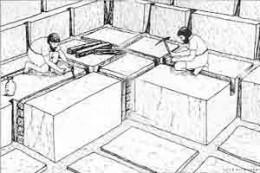
Ancient construction techniques at Herod’s Temple were more sophisticated than we might think. A stonecutter, right, uses a pickax to cut a channel in a limestone block. Meanwhile another worker, left, pours water over some logs stacked in the channel between two blocks. The water will cause the wood to swell, exerting lateral pressure on the block and splitting the block off of the bedrock to which it is attached at bottom. Because the limestone lay in natural horizontal layers, the blocks would cleave along a relatively neat, horizontal line. Studying the ancient construction methods used to create the Herodian Temple give us clues to Temple Mount history. Photo: Leen Ritmeyer
Building and furnishing the Herodian Temple involved more than stone quarrying and laying, but the stones and foundations of Herod’s Temple can give us clues to Temple Mount history.
What ancient construction techniques can be seen on the site of Herod’s Temple? What does this tell us about Temple Mount history? In the following article, “Quarrying and Transporting Stones for Herod’s Temple Mount,” Leen Ritmeyer, a specialist in Temple Mount history, looks at the quarrying effort and expertise evident in the building of the Herodian Temple.
Horizontally layered local limestone was used to build Herod’s Temple. Stonecutters cut down through blocks of stone; then wood pilings placed in the crevices were saturated with water to such an extent that the pressure broke off the block from the bedrock. Some of this limestone can still be seen uphill from the Herodian Temple in modern Jerusalem. The force of gravity was itself a helpful tool in ancient construction techniques, as well as wooden rollers and oxen. But once on the site of Herod’s Temple, the huge stones had to be set in place; some ashlars of the Herodian Temple weighing 160,000 pounds still stand at a height of 100 feet above the foundations of Herod’s Temple. The physical work of angels? Some have wondered, but ancient construction techniques at Herod’s Temple were more sophisticated than we might imagine. Temple Mount history indicates this was the site of the First Temple, and that the previous platform and additional fill dirt was used to the best advantage.
Ancient construction techniques are evident in the wall of the Herodian Temple. Not all of the stones used in the Herodian Temple weighed 160,000 pounds. Some, weighing merely a few tons, were thrown down from above when the Romans destroyed the city in 70 A.D.
For illustrations by Ritmeyer further explaining ancient construction techniques, see the following article about the Herodian Temple.
Quarrying and Transporting Stones for Herod’s Temple Mount
Leen Ritmeyer
Herod’s construction in the Temple Mount area, like the construction of most of Jerusalem’s buildings, used local limestone.
The mountains around Jerusalem are composed of Turonian and Cenomanian limestone that has a characteristic horizontal layering. These horizontal layers vary between about 18 inches and 5 feet thick. In exceptional cases, the layers are even thicker.
To quarry this limestone the stonecutter first straightened the face of the stone. This consisted of chiseling the rock in such a way as to produce a flat vertical surface—the side of the incipient stone—and a flat surface on top. Next, with a pickax he dug narrow channels 4 to 6 inches wide on all sides except the bottom of the incipient stone. In two of these grooves, at right angles, the quarryman would insert dry wooden beams, hammer them tightly into place and pour water over them. This caused the wood to swell, and the consequent pressure caused the stone to separate from the lower rock layer.
The next stage required squaring-off the stones and preparing them for transportation. The smaller stones were simply placed on wagons, according to Josephus. Some of the corner stones in the Temple Mount, however, weighed 50 tons and sometimes more. Special techniques were developed to transport these stones on large wooden rollers. While shaping the stones, the masons left 12-inch-long projections on opposite sides of each stone. These projections were later removed. In the meantime, however, ropes were placed around these projections, and two short, but strong, cranes outfitted with winches lifted the stones on one side and lowered them onto rollers. Oxen could then pull the stones with ropes placed around the projections. According to Josephus, 1,000 oxen were used in this work.
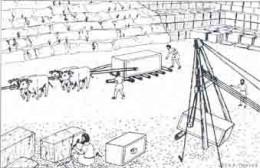
Moving the stones: Stages of quarrying and moving ashlars. In the background, at left, the unworked bedrock exhibits the natural horizontal layering of the limestone in the Jerusalem vicinity. Blocks cut, but not yet removed, appear at upper right. The thickness of the limestone layers determined the height of the blocks that were quarried. Photo: Leen Ritmeyer
The quarries were probably located near what we know today as the Russian Compound, in the heart of modern Jerusalem. There a 50-foot-long column, still attached to the bedrock, can be seen. In the process of quarrying the column, a natural fissure was observed in the rock, so the workmen simply stopped work and left the damaged column in place. The quarries in this area are 125 feet higher than the Temple Mount, so the journey of over a mile to the Temple Mount was downhill. Using the force of gravity obviously made transportation easier.
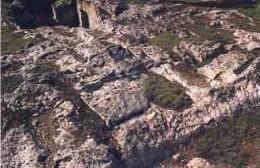
Stone quarrying: Remains of an ancient quarrying operation can be seen at a tomb complex near the Siloam Pool. Shallow, incomplete channels cut around incipient blocks appear in the bedrock. Photo: Hershel Shanks
Once the stones arrived at the building site, they had to be put in place. At both the southwest and southeast corners of the Temple Mount, stones weighing over 80 tons are still in place at a height of at least 100 feet above the foundations. How did they get there? At our excavation site, some of the more pious local laborers who worked with these stones were so awed by their size that they attributed their placement to angels. It would have been impossible, they said, for mere man to lift them into place. In a sense, they were right; no man could have lifted these stones to such a height, notwithstanding all the sophisticated Roman engineering equipment available at the time.
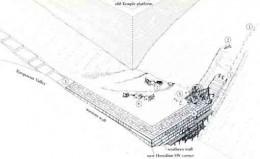 Building the wall: Building Herod’s Temple Mount wall involved several steps, as illustrated in this drawing. First the line of the wall was laid out by markers (1). Then the construction site was cleared down to bedrock (2). Next the bedrock itself had to be cut and leveled before the ashlars could be put into place (3). Oxen hauled the ashlars from the quarry on rollers (4) for a mile or so down to the construction site, which was 125 feet lower than the quarries north of the Temple Mount. A crane powered by a treadmill lowered the blocks into place (5), and once the courses had been laid, workers chiseled off the projections (6). In a few cases, a projection was not chiseled off for some reason (see photograph), thus providing archaeologists with excellent evidence of the construction process. Photo: Leen Ritmeyer
Building the wall: Building Herod’s Temple Mount wall involved several steps, as illustrated in this drawing. First the line of the wall was laid out by markers (1). Then the construction site was cleared down to bedrock (2). Next the bedrock itself had to be cut and leveled before the ashlars could be put into place (3). Oxen hauled the ashlars from the quarry on rollers (4) for a mile or so down to the construction site, which was 125 feet lower than the quarries north of the Temple Mount. A crane powered by a treadmill lowered the blocks into place (5), and once the courses had been laid, workers chiseled off the projections (6). In a few cases, a projection was not chiseled off for some reason (see photograph), thus providing archaeologists with excellent evidence of the construction process. Photo: Leen Ritmeyer
In fact, the stones did not have to be lifted from below. They were actually lowered into place from above. The 16-foot-thick walls of the Temple Mount are basically retaining walls, built to retain the high pressure of the fill that was dumped between the previous platform and the new Temple Mount wall. This was Herod’s way of enlarging the previous platform to twice its original size. Herod’s engineers solved the construction problem by pouring the internal fill simultaneously with the construction of the walls. Thus, the first course of stones was laid in the valley surrounding the previous Temple Mount. Then the area between the new and old walls was filled up to the level of the top of this course. This created a new work-level on top of which, from the inside, a second course of stones could be laid. Again fill would be added on the inside, so that a third course of stones could be laid. And so on, course after course, until the whole of Herod’s extension was raised up to the level of the previous Temple platform.
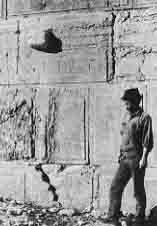
On this block from the southeast corner of the Temple Mount wall, the projection used for maneuvering the stone was not chiseled off, thus providing archaeologists with excellent evidence of the construction process. Photo: Leen Ritmeyer
The buildings on the Temple Mount were built of smaller stones. Stones from these structures were thrown down into the street below when the Romans destroyed Jerusalem in 70 A.D. Most of them were later scavenged for other construction. But a few were found in the excavations. These weighed between two and three tons. Stones of this size would have posed no problem for the skilled builders of Herod’s Temple Mount.